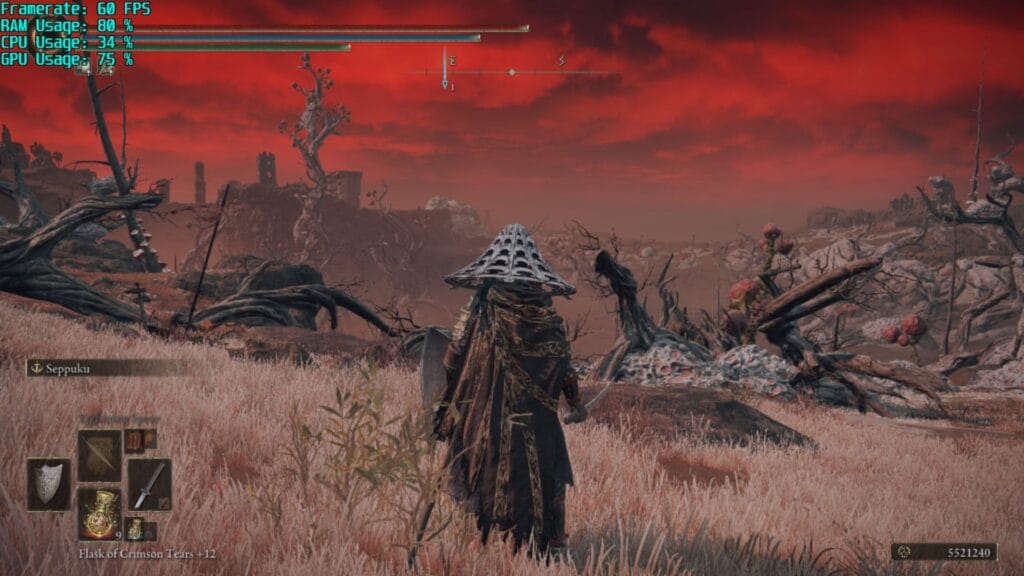Performance Overview

Elden Ring can’t reach a stable 60 frames per second on the ASUS ROG Ally but it can get to a smooth framerate with a few tweaks.
Enabling Turbo Mode at 30 watts is the best way to play Elden Ring. That does mean you need to be connected to a power supply, but it’ll provide the smoothest experience. I averaged 50 to 55 frames per second in this mode and the game looks and feels lush. Plus you’re only five to 10 frames off 60, so the performance is more than playable.
There are some caveats, though. Rain will absolutely tank the framerate and certain areas will cause frame drops. There isn’t much you can do about this either as it’s an Elden Ring problem rather than an ASUS ROG Ally issue. I saw similar results when I played Elden Ring on the Steam Deck. The game just isn’t as optimized for handhelds as it could be.
If you hate being plugged in, you can get by on Turbo Mode at 25 watts, though the five fewer watts will dramatically change the experience. Expect the framerate to average around the 45 mark with drops down to 39 when things get hectic.
Dropping the power down further isn’t recommended but I tried it anyway just to see what’s what. Performance Mode, which runs at 15 watts, drops the framerate all the way down to 30, with drops as low as 26 and 27 frames per second. Don’t play like this. It’s not fun.
Recommended Settings

As mentioned above, the goal of my settings is to get in the 60-frames-per-second ballpark. I averaged 50 to 55 frames per second, with drops rarely going lower than 45. The main thing for most players is that Elden Ring feels fluid, and these settings do just that.
Just keep in mind the game runs very hot at 90 degrees and if you unplug the official charger you’ll drop down to Turbo Mode at 25 watts, which results in around 90 minutes of playtime. Switching to Performance Mode will get you the best battery life at around two hours 30 minutes, but the game will then run at 30 frames per second and feel sluggish. You also may need to crank all the settings down to low. So not only do you have a jumpy game, it also looks like a jaggedy mush.
That’s why I recommend sticking with Turbo Mode at 30 watts. It’s not ideal needing to play while plugged in, but for the best performance and as a way to nullify the battery issue, that’s the best way to play.
| (In-game Settings) | |
| Resolution |
1280×720 (16:9) |
| Ray Tracing | Off |
| Texture Quality | Medium |
| Antialiasing Quality | High |
| SSAO | Off |
| Depth of Field | Low |
| Motion Blur | Off |
| Shadow Quality | Low |
| Lighting Quality | Medium |
| Effects Quality | Low |
| Volumetric Quality | Medium |
| Reflection Quality | Low |
| Water Surface Quality | Low |
| Shader Quality | Low |
| Global Illumination Quality | Low |
| Grass Quality | Medium |
| ASUS ROG Ally Settings | |
| Profile: Turbo 30w (50-55 frames per second) | Estimated Battery Life: 1 Hour 30 Minutes |
| Docked Mode Resolution: 1280×720 | RSR: On |
| GPU Usage: 84% | CPU Usage: 29% |
| RAM Usage: 80% | Temperature: 90 degrees |
| Performance Rating: 4/5 | |
Bugs and Issues
Aside from general issues here and there, Elden Ring isn’t a buggy game. It works and works well. The biggest gripe is how much rain tends to kill the framerate. It’s not a major problem, but it’s something to be aware of. Never get into fights when it’s raining. It’s not worth it. Just walk away.
Steam Deck Comparison

Not only does the ASUS ROG Ally version of Elden Ring look better than the Steam Deck equivalent, it also performs better.
I recommended playing Elden Ring on Steam Deck at a locked 30 frames per second. Even though the game could go higher, the inconsistencies made it more difficult to play. By locking it to 30, you could adapt to the surroundings and mentally recognize different cues.
Over on the ASUS ROG Ally, frames are nearly doubled and by using fewer low settings, the game looks even better.
Verdict

Even though Elden Ring can’t hit 60 frames per second on the ASUS ROG Ally, it’s smooth enough now to be a true PC experience. The game looks great on the Ally’s seven-inch screen, the extra power means things look nicer, and the framerate is smooth for the most part.
If you already own Elden Ring or are looking to play it on the go for the first time, the ASUS ROG Ally version comes easy to recommend.

All screenshots captured on ASUS ROG Ally.| To learn more about our review policy click here. | Alternatively, click here to find out why you can trust me.

